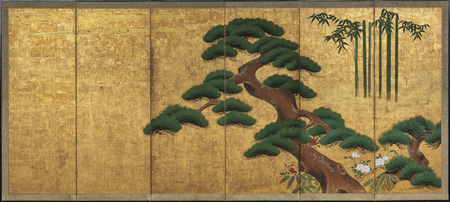Product Description
C001 A six-fold paper screen painted in ink and colour on a gold ground with pine trees, bamboo and blossoming red and white roses.
Japan 18th century Edo period
Dimensions: H. 169.5cm x W. 376cm (66¾” x 148¼”)
The matsu (pine tree) holds a prominent role in Japanese art, largely due to its auspicious associations which were originally adopted from Chinese traditions. This evergreen has long been seen as a symbol of longevity, steadfastness and good fortune due to its ability to remain green and fresh even during the fiercest of winters. Furthermore, in Japan the pine has always been prized for its practical uses, and its attractive appearance lends itself to being creatively represented in both painting and design.
The take (bamboo) represents strength, vitality, flexibility, dependability and survival through adversity due to its evergreen nature and delicate structure which bends in the wind, but never breaks. Its core is empty and this emptiness symbolises purification and an egoless state, highly regarded in Buddhism. Along with pine and plum, bamboo is also one of the ‘Three Friends of Winter’ which is a popular theme in Japanese art and culture.
There are some native species of bara (rose) in Japan and roses appeared in literature of as early as the Nara period (710-794), including: the Japanese oldest collection of poetry Manyōshū (Collection of Ten Thousand Leaves) and Hitachi-no-kuni-fudoki (Topography of Hitachi Province [today’s Ibaraki prefecture], completed in 721). By the Edo period, more species had been imported from China and numerous varieties of roses have been cherished in Japan ever since.










